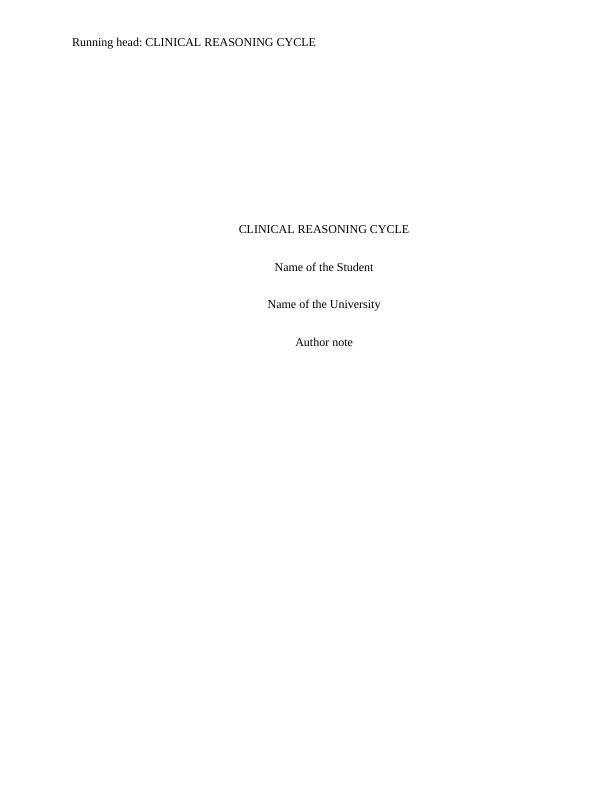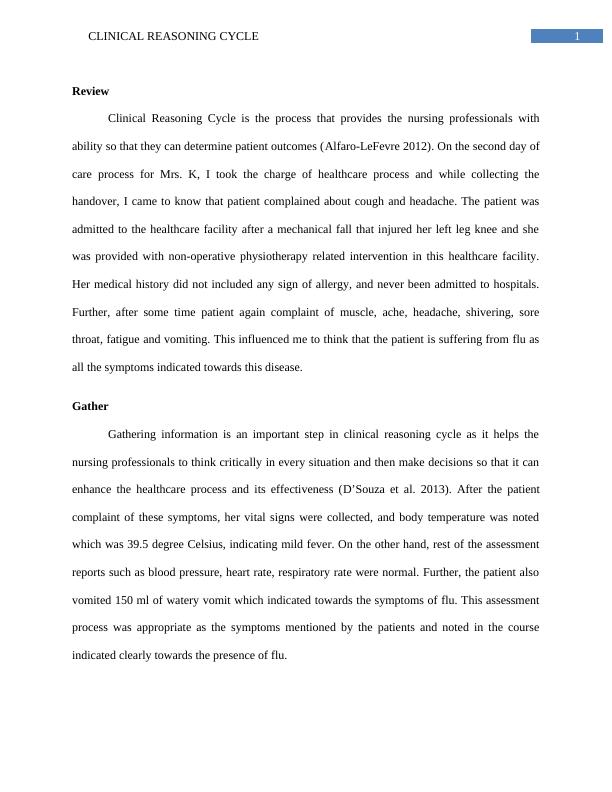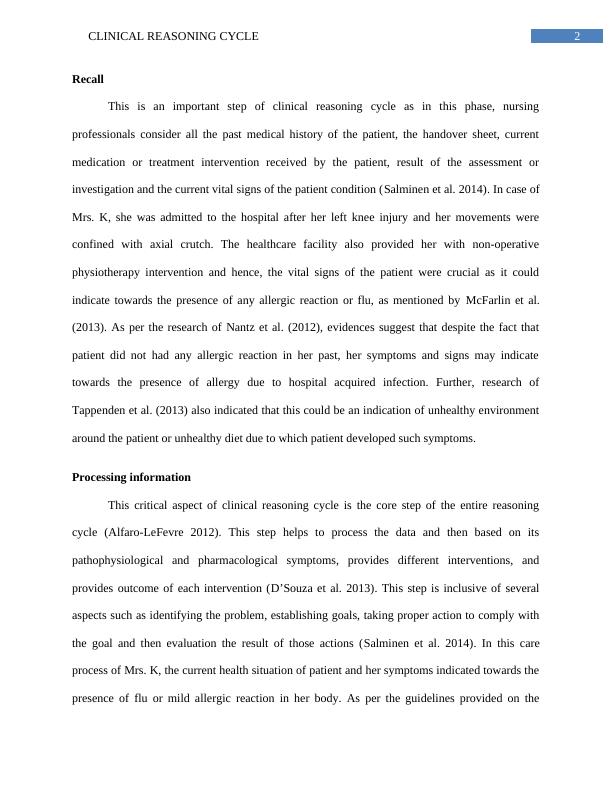Clinical Reasoning Cycle for Nursing Professionals
Added on 2023-04-22
8 Pages1894 Words353 Views
Running head: CLINICAL REASONING CYCLE
CLINICAL REASONING CYCLE
Name of the Student
Name of the University
Author note
CLINICAL REASONING CYCLE
Name of the Student
Name of the University
Author note

1CLINICAL REASONING CYCLE
Review
Clinical Reasoning Cycle is the process that provides the nursing professionals with
ability so that they can determine patient outcomes (Alfaro-LeFevre 2012). On the second day of
care process for Mrs. K, I took the charge of healthcare process and while collecting the
handover, I came to know that patient complained about cough and headache. The patient was
admitted to the healthcare facility after a mechanical fall that injured her left leg knee and she
was provided with non-operative physiotherapy related intervention in this healthcare facility.
Her medical history did not included any sign of allergy, and never been admitted to hospitals.
Further, after some time patient again complaint of muscle, ache, headache, shivering, sore
throat, fatigue and vomiting. This influenced me to think that the patient is suffering from flu as
all the symptoms indicated towards this disease.
Gather
Gathering information is an important step in clinical reasoning cycle as it helps the
nursing professionals to think critically in every situation and then make decisions so that it can
enhance the healthcare process and its effectiveness (D’Souza et al. 2013). After the patient
complaint of these symptoms, her vital signs were collected, and body temperature was noted
which was 39.5 degree Celsius, indicating mild fever. On the other hand, rest of the assessment
reports such as blood pressure, heart rate, respiratory rate were normal. Further, the patient also
vomited 150 ml of watery vomit which indicated towards the symptoms of flu. This assessment
process was appropriate as the symptoms mentioned by the patients and noted in the course
indicated clearly towards the presence of flu.
Review
Clinical Reasoning Cycle is the process that provides the nursing professionals with
ability so that they can determine patient outcomes (Alfaro-LeFevre 2012). On the second day of
care process for Mrs. K, I took the charge of healthcare process and while collecting the
handover, I came to know that patient complained about cough and headache. The patient was
admitted to the healthcare facility after a mechanical fall that injured her left leg knee and she
was provided with non-operative physiotherapy related intervention in this healthcare facility.
Her medical history did not included any sign of allergy, and never been admitted to hospitals.
Further, after some time patient again complaint of muscle, ache, headache, shivering, sore
throat, fatigue and vomiting. This influenced me to think that the patient is suffering from flu as
all the symptoms indicated towards this disease.
Gather
Gathering information is an important step in clinical reasoning cycle as it helps the
nursing professionals to think critically in every situation and then make decisions so that it can
enhance the healthcare process and its effectiveness (D’Souza et al. 2013). After the patient
complaint of these symptoms, her vital signs were collected, and body temperature was noted
which was 39.5 degree Celsius, indicating mild fever. On the other hand, rest of the assessment
reports such as blood pressure, heart rate, respiratory rate were normal. Further, the patient also
vomited 150 ml of watery vomit which indicated towards the symptoms of flu. This assessment
process was appropriate as the symptoms mentioned by the patients and noted in the course
indicated clearly towards the presence of flu.

2CLINICAL REASONING CYCLE
Recall
This is an important step of clinical reasoning cycle as in this phase, nursing
professionals consider all the past medical history of the patient, the handover sheet, current
medication or treatment intervention received by the patient, result of the assessment or
investigation and the current vital signs of the patient condition (Salminen et al. 2014). In case of
Mrs. K, she was admitted to the hospital after her left knee injury and her movements were
confined with axial crutch. The healthcare facility also provided her with non-operative
physiotherapy intervention and hence, the vital signs of the patient were crucial as it could
indicate towards the presence of any allergic reaction or flu, as mentioned by McFarlin et al.
(2013). As per the research of Nantz et al. (2012), evidences suggest that despite the fact that
patient did not had any allergic reaction in her past, her symptoms and signs may indicate
towards the presence of allergy due to hospital acquired infection. Further, research of
Tappenden et al. (2013) also indicated that this could be an indication of unhealthy environment
around the patient or unhealthy diet due to which patient developed such symptoms.
Processing information
This critical aspect of clinical reasoning cycle is the core step of the entire reasoning
cycle (Alfaro-LeFevre 2012). This step helps to process the data and then based on its
pathophysiological and pharmacological symptoms, provides different interventions, and
provides outcome of each intervention (D’Souza et al. 2013). This step is inclusive of several
aspects such as identifying the problem, establishing goals, taking proper action to comply with
the goal and then evaluation the result of those actions (Salminen et al. 2014). In this care
process of Mrs. K, the current health situation of patient and her symptoms indicated towards the
presence of flu or mild allergic reaction in her body. As per the guidelines provided on the
Recall
This is an important step of clinical reasoning cycle as in this phase, nursing
professionals consider all the past medical history of the patient, the handover sheet, current
medication or treatment intervention received by the patient, result of the assessment or
investigation and the current vital signs of the patient condition (Salminen et al. 2014). In case of
Mrs. K, she was admitted to the hospital after her left knee injury and her movements were
confined with axial crutch. The healthcare facility also provided her with non-operative
physiotherapy intervention and hence, the vital signs of the patient were crucial as it could
indicate towards the presence of any allergic reaction or flu, as mentioned by McFarlin et al.
(2013). As per the research of Nantz et al. (2012), evidences suggest that despite the fact that
patient did not had any allergic reaction in her past, her symptoms and signs may indicate
towards the presence of allergy due to hospital acquired infection. Further, research of
Tappenden et al. (2013) also indicated that this could be an indication of unhealthy environment
around the patient or unhealthy diet due to which patient developed such symptoms.
Processing information
This critical aspect of clinical reasoning cycle is the core step of the entire reasoning
cycle (Alfaro-LeFevre 2012). This step helps to process the data and then based on its
pathophysiological and pharmacological symptoms, provides different interventions, and
provides outcome of each intervention (D’Souza et al. 2013). This step is inclusive of several
aspects such as identifying the problem, establishing goals, taking proper action to comply with
the goal and then evaluation the result of those actions (Salminen et al. 2014). In this care
process of Mrs. K, the current health situation of patient and her symptoms indicated towards the
presence of flu or mild allergic reaction in her body. As per the guidelines provided on the

End of preview
Want to access all the pages? Upload your documents or become a member.
Related Documents
Preventing Clinical Reasoning Bias in Nursing: A Case Studylg...
|8
|2322
|395
Nursing Clinical Reasoning Cycle Case Studylg...
|8
|1641
|125
Clinical Reasoning Cycle for Hypovolemia, Dehydration and Hypotensionlg...
|6
|1448
|220
Integrated Nursing Practice: Pain Management Comparison and Interventionlg...
|10
|2823
|300
Nursing Reflection on NSQHS Standards 4 and 5lg...
|6
|1450
|313
Case Study on Clinical Reasoning Cyclelg...
|10
|2635
|261
